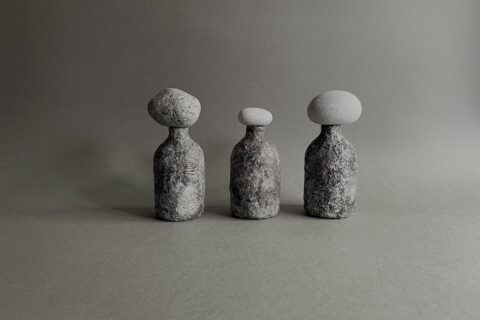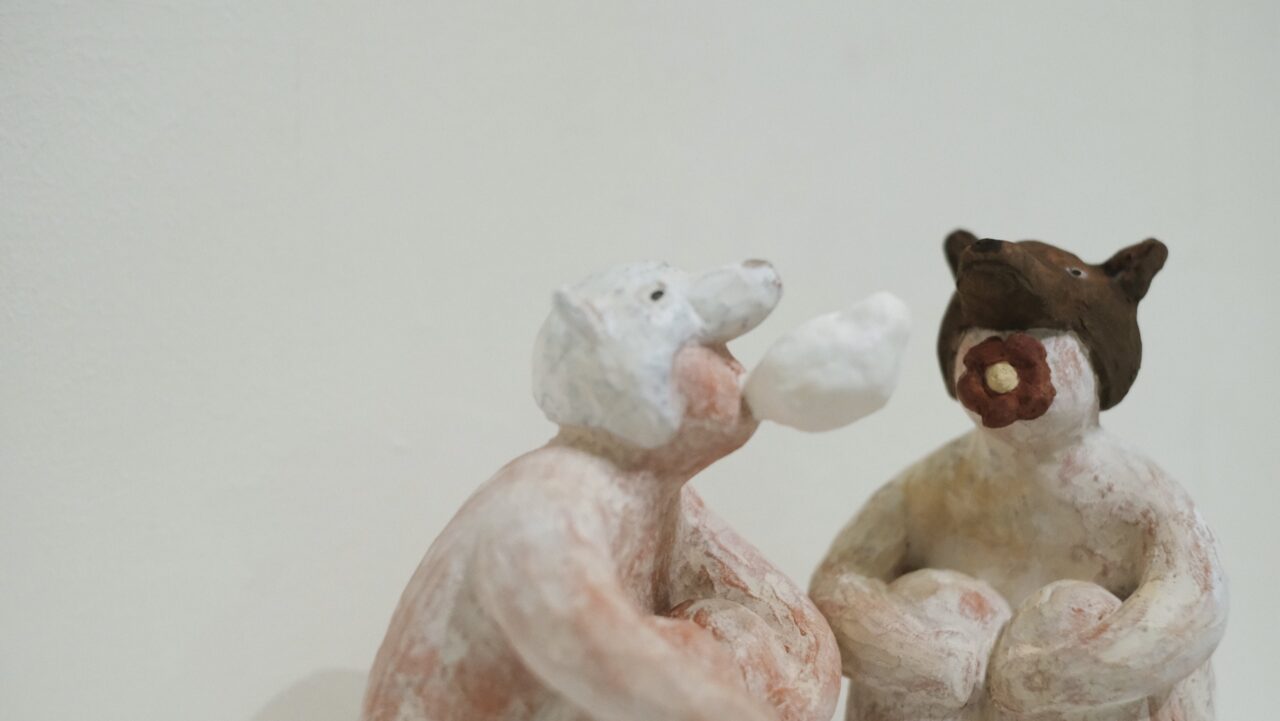
比起陶土作品的順滑,乍看Mocca的作品更像「紙漿偶」或是木雕,但那的確是陶土製造,手捏、窯燒、打磨、上釉。長大,學會更多,透過雙眼看到、腦袋立即從資料庫分析那是甚麼,我覺得也是一種「長大」。想到這點,我還是放輕鬆地欣賞作品,無論是陶、紙漿、木雕,那原形被手捏、雕塑之後,呈現了甚麼呢?
「ㄧ個人隨著時間變化,自主的或被動的變得世故或妥協,或許這就是所謂的長大吧!」創作人Mocca正在回答我對「何為長大」的提問。

比起陶土作品的順滑,乍看Mocca的作品更像「紙漿偶」或是木雕,但那的確是陶土製造,手捏、窯燒、打磨、上釉。長大,學會更多,透過雙眼看到、腦袋立即從資料庫分析那是甚麼,我覺得也是一種「長大」。想到這點,我還是放輕鬆地欣賞作品,無論是陶、紙漿、木雕,那原形被手捏、雕塑之後,呈現了甚麼呢?
「ㄧ個人隨著時間變化,自主的或被動的變得世故或妥協,或許這就是所謂的長大吧!」創作人Mocca正在回答我對「何為長大」的提問。
「內在小孩」是這次展覽的主題,Mocca的作品有著強烈的故事感,但不是故事書,倒更像立體的插畫。「一開始是基於對繪本以及藝術的喜好,因此上了坊間以插畫風格為主的繪畫課程。後來將自己的想像立體化的想法愈來愈強烈,便接著開始紙漿偶、陶偶課程的學習。一路走來,從平面到立體的喜好,感覺這是非常自然的轉換。」原來如此,從平面的繪畫延伸到陶偶,理所當然,更像成長。
成長需要時間,而且是不知不覺,我們並不會突然發現我已長大、甚至老去,直到有一刻孩子長大離家,當重新編寫時間表時,才發現我們都長大了。「我的孩子目前已成年且在外地求學,所以比其他需要家庭與藝術兼顧的創作者有更多時間、空間做自己喜歡的事,這令我常以感恩的心情來面對創作這件事。」這些作品是出自一位媽媽的手,創作的初心並沒有被身份磨掉,用陶作來寄託曾經對自己的期待、念想。
「一開始,孩子的點滴日常是自己創作的靈感來源,或是揑塑的是孩子曾經發生的往事經驗。但我慢慢發現,自己深層的本我逐漸釋放出來。人總是想對一直往前走又不回頭的時間做一些對抗的行為,或許這些陶偶記錄了自己曾經發生過的情緒。」本我,那個包括像孩子的我,原來沒有因為成長而不存在,相反,成為了我們內在的孩子,同樣需要被照顧、安慰、看到。凝視Mocca的作品,確實有老靈魂的感覺,那戴著長頸鹿帽子、只穿紅色游泳褲的男生,正在用望遠鏡看世界,作品名是《好奇》。「好奇」並不是孩子獨有的渴望,只是長大了我們或更需要確切地、更慎重地了解我們正在花時間好奇了甚麼?尋找著真相、感知到實在,回歸到內在,帶著內在小孩一起經歷成長。
顏色,我好奇那像磨砂但又鮮明的色彩。「我認為世間萬物都有他的道,對我來說,以膠彩畫(即日本畫)所使用的天然顏料:胡粉(牡蠣殼研磨出來的粉)、水干(牡蠣殼粉染成後的顏料)、泥土顏料為素胚陶上色來完成整個創作就是我的陶偶的和諧之道吧!」這種方法在一般的陶器上並不常見,但是在陶偶創作中,以天然顏料混膠上色,更像使用木顏色、乾粉彩,夢幻地增添故事感。「將源於大自然的陶土以及天然的顏料結合,展現出的是造型色彩整體更為歸一的氣質,這便是我之所以選擇這樣方式完成創作的原因之一。」Mocca說到氣質,這又讓人聯想如果長大只是加添了「氣質」,我們長大後或不用專注在安慰內在小孩,因為我就是我,那個時候的我都是我,我再看著眼前的作品,不就是包含了這樣的智慧嗎?不圓滑的陶土表面不是主流,但正因為結合了內在小孩和長大後的我,成為了現在的我。
At first glance, without the typically smooth textures of ceramic, Mocca’s creations appear more like papier-mâché or wood carvings. Yet, they are indeed made of clay; crafted through the processes of hand molding, firing, polishing, and glazing. As we grow and learn, we develop the ability to instantly analyze and identify what we see. However, when it comes to appreciating artwork, instead of focusing on what they are made from, be it clay, paper pulp, or wood, I find myself drawn to thinking of what truly lies beneath the surface.
“As a person evolves over time, they become more worldly or they compromise their ideals, whether through their own choices or due to external circumstances. Perhaps this is what ‘growing up’ means,” Mocca explained, in response to my question about the meaning of “growing up.”
“The Child Within” is the central theme for this exhibition. Mocca’s work possesses strong narrative qualities; yet rather than storybooks, they are more like three-dimensional illustrations. “Driven by my passion for picture books and art, I started taking drawing classes that emphasized an illustrative style. Over time, I felt a growing desire to bring my imagination to life in a three-dimensional way. So I embarked on courses in papier-mâché and clay figurine sculpting. Looking back, the transition from illustration to three-dimensional creation felt incredibly organic.” It all came so naturally, just like growing up.
The process of growing up is gradual and often goes unnoticed. We don’t suddenly wake up one day and realize that we have grown up or even aged. It is only when our children grow up and leave home and we find ourselves reassessing our own lives and plans for the future that we truly come to understand that we have undergone the journey of growing up. “My child has now grown up and is studying abroad. So compared to other artists who have to navigate the delicate balance between family and their artistic pursuits, I have more time and space to do what I love. This fills me with a sense of gratitude for the opportunities and freedom I have to fully immerse myself in art.” These pieces of art are crafted by Mocca, who never let go of her passion for art despite the additional responsibilities of motherhood. Through clay, she tells the world of the expectations and aspirations she once held for herself.
“At the beginning, I drew inspiration from my child’s everyday moments, and I would use clay to bring their stories to life. But then, I found my true self slowly emerging. As humans, we often feel the need to resist the relentless passing of time. These clay figures have probably captured the emotions I have experienced along the way.” The “true self,” which encompasses our childlike aspects, doesn’t cease to exist as we grow up. Rather, it transforms into an inner child within us that needs to be nurtured, comforted, and noticed. When I look at Mocca’s artwork, I sense a depth of wisdom and maturity within them. One specific piece titled, “Curiosity,” captures my attention. It depicts a boy wearing a giraffe hat and red swimming trunks, observing the world through a telescope. Curiosity is not exclusive to children. It’s just that as we grow older, we become more deliberate and discerning in our curiosity, leading us to seek truth, perceive reality, and reconnect with our inner selves, experiencing growth alongside our inner child.
I am curious about that matte, yet vibrant color. “I believe that everything in the world has its own way. For me, using natural pigments that are often used in nihonga (literally means “Japanese-style paintings”), such as gofun (made with oyster shell powder), suihi (adding dye to gofun), and mud pigment, to color the clay produce a harmonious and visually pleasing outcome.” It’s rather uncommon to use nihonga pigments in pottery. However, incorporating these pigments adds a distinctive and enchanting quality to ceramic work, similar to how colored pencils and pastels bring a dreamlike essence to paintings. “One of the reasons why I choose to combine clay and natural pigments is that it creates a cohesive and harmonious temperament in terms of form and color.” If growing up is only about creating a certain temperament, then maybe we don’t necessarily need to focus on comforting our inner child as we grow older? Despite growing and evolving, we are the same person, and the person we were in the past remains a part of us. Isn’t this what Mocca is trying to convey to us through her work? Differing from the smooth textures typically seen in pottery, the rough texture of Mocca’s work symbolizes the merging of her inner child and the person she has grown into. And it is what shapes the person she is today.